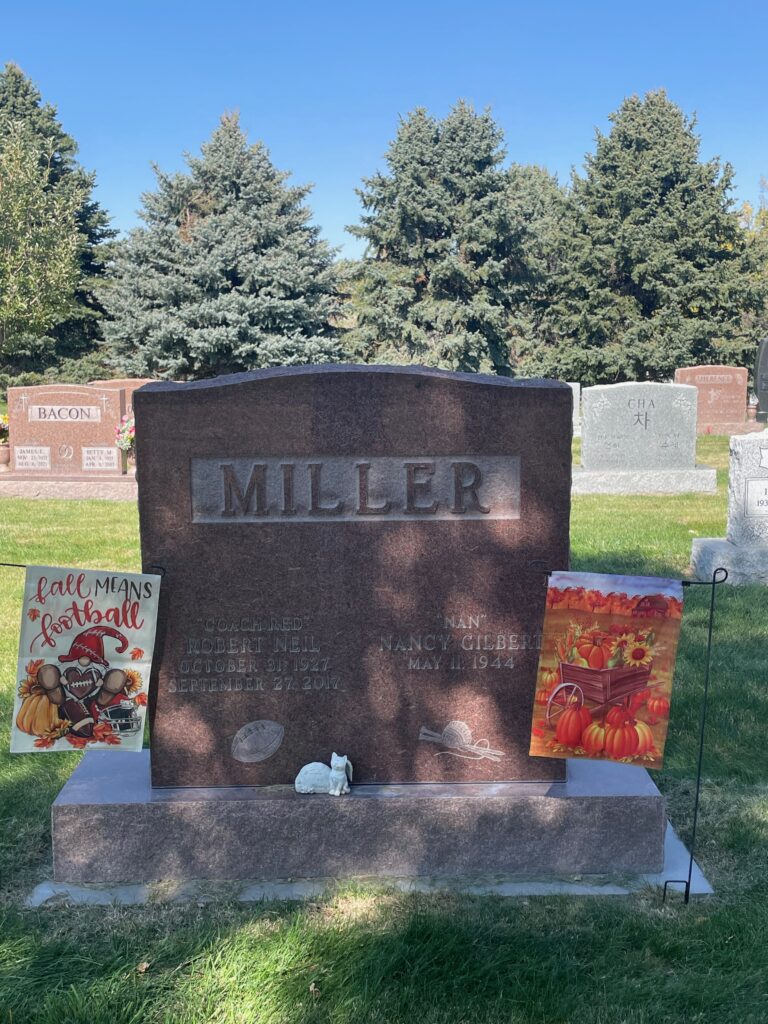Erik Visits an American Grave, Part 1,983
This is the grave of Red Miller.

Born in 1927 in Macomb, Illinois, Miller grew up there, the son of a coal miner. He was called Red because he had red hair. People are so sophisticated with nicknames. He then went to Western Illinois University to play football. And maybe to study too. He was a good player and then went into coaching at local high schools and then Carthage College in Wisconsin. He became a protege of Lou Saban when the latter was coaching at Western Illinois. Saban hired Miller as an assistant and then brought him to the Boston Patriots when that became one of the teams in the new American Football League in 1960. Despite coaching at a small school, Saban’s reputation was strong enough that he became the first coach of the Patriots. Miller was an offensive line coach and he spent the next decade moving around the AFL and NFL as an OL coach on a lot of different teams. He stayed with the Patriots for two years, then went to the Buffalo Bills in 1962, the Denver Broncos between 1963 and 1965, then the St. Louis Cardinals from 1966-1970, the Baltimore Colts in 1971 and 1972, and then back to the Patriots between 1973 and 1976.
After the 1976 season, John Ralston resigned as the head coach of the Broncos because the players were revolting against him. Under Ralston, the Broncos were a decent team who tended to be a tick over .500 but never made the playoffs. It was a good situation for a rookie head coach to enter to, as Red Miller was when the Broncos hired in 1977. The defense was great–this was the Orange Crush team with Randy Gradishar and Tom Jackson and Lyle Alzado before he went full thug with the Raiders. But the team really need a decent quarterback to charge its offense. The team traded for Craig Morton. Well, Morton wasn’t exactly a great QB but by the standards of the time, he was OK and with a great defense, you could win with him.
Well, that wasn’t quite the case because Morton wasn’t quite good enough. But the Broncos were very good for several years this way. 1977 was a pretty great year for the Broncos and everyone credited Miller, who was Coach of the Year. They went 12-2, dominated the AFC, waltzed through the playoffs, and then played the Dallas Cowboys in Super Bowl XII. Incidentally, the was the first Super Bowl to be broadcast in prime time. And it was a dominant performance for the Cowboys. Morton just wasn’t very good at this level. The Cowboys won 27-10 after the Broncos turned the ball over seven times in the first half and Morton got pulled for being terrible. Well, it was still a successful season for the Broncos. But they couldn’t get back. They remained good for the next several years, but kept stumbling in the playoffs. They won the AFC West in 1978, the first year of the 16 game season, at 10-6, but lost to the Steelers in the divisional round. They lost again in 1979 in the playoffs, to the Houston Oilers. In 1980, the team only went 8-8. After that season, the team was sold to Edgar Kaiser, who believed that Miller was not the man for the job. He fired Miller and hired Dan Reeves. Ultimately, that was probably the right call.
Interestingly, Miller never got another call from the NFL. He became the coach of the Denver Gold in the new USFL in 1983, but he and the owner hated each other and that only lasted one year. I suspect he mostly decided he didn’t want to leave Denver at this point. He ended up working as a stockbroker for awhile. He lived there the rest of his life, dying in 2017, at the age of 89. It was a stroke that felled him, while watching the Broncos play the Chargers on Monday Night Football.
Red Miller is buried in Fairmount Cemetery, Denver, Colorado.
If you would like this series to visit other NFL Coaches of the Year, you can donate to cover the required expenses here. Forest Gregg, who won it in 1976 while coaching the Cleveland Browns to a 9-5 record (really anyone who coaches the Browns to a winning record in any era probably deserves it) is in Colorado Springs, Colorado. Ted Marchibroda, who won 1975 with the Baltimore Colts, is in Kilmarnock, Virginia. Previous posts in this series are archived here and here.


